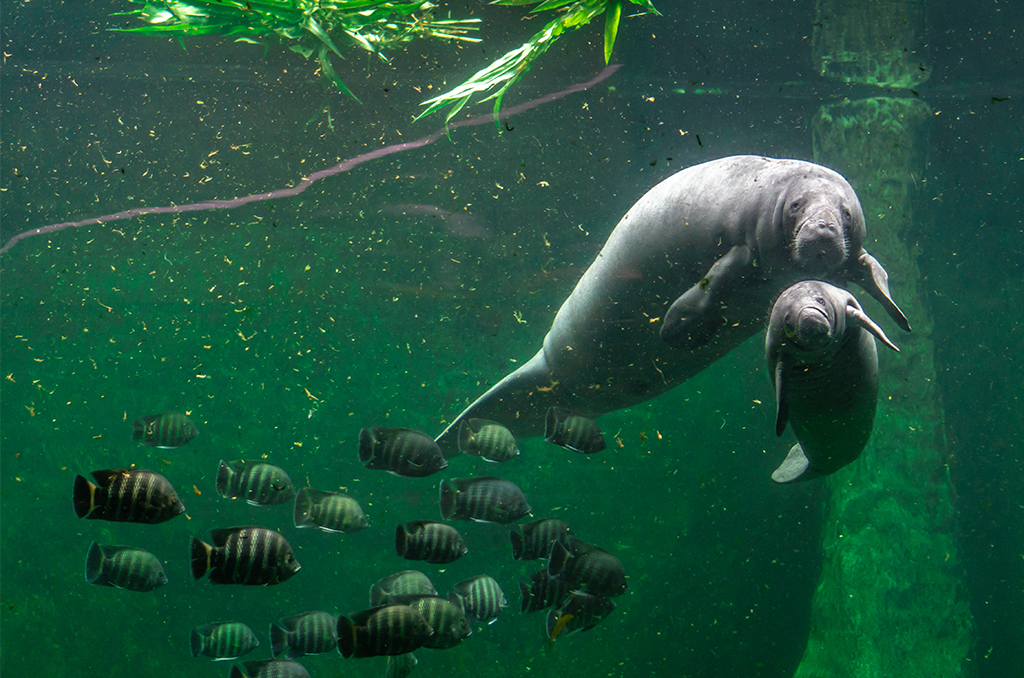Manatees — Courtesy: Shutterstock — Image by: Lukasz Machowczyk
Manatees in Florida were driven from warm springs to power plants by pollution. Their new built homes are disappearing as the state moves toward renewable energy.
On the Gulf Coast of the state, close to Apollo Beach, the huge, gray, barnacled Florida manatees idly float close to the surface of the sheltered canal.
Since manatees cannot survive in temperatures below than 20C (68F), the water is heated to the ideal temperature for them. The warm water springs spread throughout Florida are the natural homes of manatees, where the creatures graze on seagrass for up to eight hours per day.
But these manatees of Apollo Beach, also called “sea cows” with affection, aren’t eating on the bottom of the turquoise artesian springs, which are encircled by trees covered in Spanish moss and lined with limestone rock. Rather, a massive coal-fired power station towers over the animals, emitting warm water, a leftover from the business.
An ‘unbelievable’ puzzle
As natural springs along the Atlantic coast have been virtually destroyed by development, these manatees’ ancient feeding grounds have become dependent on coal and gas power plants. This is according to Elizabeth Fleming, a conservationist and manatee expert at the nonprofit Defenders of Wildlife.
It’s getting to the point when these power facilities will be shut down as the US transitions to renewable energy, which will mean the manatees’ artificial warm water supply will vanish. “It is one of the most unbelievable human-wildlife conundrums I’ve ever seen in my life,” Fleming adds. “We have totally reengineered their whole habitat.”
Manatees have been visiting these power plants—including one in Indian River Lagoon near Cape Canaveral—for years. However, as Florida goes toward net zero by 2050, the power companies will probably phase out these warm water discharges over the course of the next 30 years.
“We have destroyed all their springs on the Atlantic Coast,” adds Fleming. “We’ve got to figure out how to get these manatees to go to other places.” “We must begin [transitioning manatees] now to avoid catastrophic losses of the Florida manatee population,” according to a 2023 warm water Florida manatee action plan.
A manatee-frequented power plant was altered in 1997 to comply with water quality regulations, which resulted in the removal of its artificial warm water discharge. Warm water is created when cold water is used to cool steam and generate electricity. The manatees perished from cold stress since they were unable to leave the location, despite being accustomed to relying on the warm water to survive the winter.
Seagrass, which cannot thrive in contaminated waters, does not necessarily exist in the warm water that manatees require from the power plants. Due to pollution and nutrient runoff, 47,000 acres (19,000 ha) or 58% of the seagrass in the Indian River Lagoon perished between 2011 and 2019. Additional calculations by the nonprofit organization Save the Manatee, which tracks manatee numbers and pushes for more robust safeguards, have the seagrass loss at about ninety percent.
The manatees would not go from the Indian River Lagoon, where they were by now routinely attracted by the artificially heated water. Thus, they perished from starvation. In the years 2021–2022, 1,900 manatees perished. “It was unprecedented,” says Save the Manatees founder Pat Rose.
“It took a tragedy for people to understand what was happening to these manatees.” Necropsies, which are typically performed on dead manatees, were discontinued by the scientists of the Florida Wildlife Commission since so many of the creatures died.
Desperate actions
Scientists devised a desperate scheme to save the manatee population: they would feed them romaine lettuce if there was no seagrass available. The Let Them Eat Lettuce program, which Rose assisted in overseeing, fed almost 600,000lb (272,155kg) of lettuce to the manatee population on Florida’s east coast over a two-year period, primarily in the Cape Canaveral area. It worked, and by the winter of 2023, the manatees had recovered enough to allow them to suspend the experiment.
Manatees face threats beyond habitat loss and seagrass depletion; 96% of Florida’s manatee population bears body scars from boat incidents. “Virtually every manatee alive has been within an inch or two of losing its life,” says Rose. “The leading cause of their injuries and mortalities is still watercraft collisions.” Manatees and hundreds of thousands of vessels share Florida’s waters. Propellers can inflict both blunt and sharp force injuries to manatees, and accidents are responsible for about 25% of fatalities. Nevertheless, many of the natural springs that manatees depend on for existence still allow the use of motorized boats.
Rose, who contributed create the 1978 Florida Manatee Sanctuary Act, which makes it illegal for “any person, at any time, intentionally or negligently, to annoy, molest, harass, or disturb any manatee,” says, “The sanctuaries we have for them are just much too small.” The act also created protection zones, which mandate that vessels maintain a low speed limit or are prohibited from entering specific areas. In 2023, human activities claimed the lives of at least 104 manatees, in spite of these precautions. “We’re far from protecting all of the areas we need to protect,” Rose states. “We’ve come a long way but we’ve got much farther to go.”
Preserving for the future
Though slowly, progress is being made, according to Rose. A new set of questions was added to the boater safety course, which became mandatory for anybody operating a boat in Florida, in 2023. Among the questions was how to prevent boats from hurting manatees. Additionally, efforts have been made to revitalize organic springs. After significant floods, Warm Mineral Springs had restoration work that was finished late last year by the Florida Fish and Wildlife Conservation Commission (FWC). Although the FWC has not yet released manatee numbers for the previous winter, the area is off-limits to entry from winter until spring to allow the manatees to continue their undisturbed access to their warm water habitat.
Florida gave manatee programs more than $50 million (£40 million) in funding in 2019, and the state recorded the lowest manatee mortality rate since 2017. An additional $258 million, totaling $325 million, has been spent to repair Florida’s springs. Record-breaking 932 manatees were counted in January 2024 in Blue Spring State Park, which has been engaged in restoration efforts since 1970. Only fourteen of the mammals were counted by park rangers when the rehabilitation project initially started.
The US Army Corps of Engineers has built whole thermal refuges in some locations, while some of the state’s natural springs have been dredged to facilitate manatee access. In order to give manatees access to warm enough water to survive the winter, a set of three basins measuring 20 feet (6 meters) deep were built in 2015 on a 10-acre (4-hectare) plot of land south of Port of the Islands in the Everglades. According to the US Fish and Wildlife Service, manatees have been utilizing the specially constructed refugium. Although this is a third fewer than past years because the temperatures just outside the refugium are still high enough for manatees, a representative for the FWC, which oversees the refugium, told the BBC that their most recent count was 48 manatees. In essence, the manatees now have choices about where to spend the winter because of the milder temperature. Some proposals that have not yet been implemented include using solar-powered heaters or putting in place a transportable heating system that manatees might use. (In 2011, manatees were given access to water heaters to aid them during the winter, soon after a power plant was shut down.)
Scientists are trying in other parts of the state where seagrass is grown in big tanks and then moved to Indian River Lagoon. A seagrass nursery being established by Florida Atlantic University will provide a ready supply of seagrass that can be transplanted for rehabilitation projects. In addition, they are investigating the genetic variety of seagrass to learn how to develop faster-growing and more environmentally-tolerant variants.
Even the most optimistic forecasts, meanwhile, indicate that it might take 12 to 17 years for seagrass to return. Some strategies center on education, such as persuading homeowners of waterfront lawns not to fertilize them in order to stop pollution runoff into manatee habitats. Moving the manatees will be a costly and time-consuming procedure. Even the government acknowledges that it has taken 50 years for the manatees to become dependent on power plants, and that weaning them off may take the same length of time.
According to Rose, efforts to conserve the manatees will benefit the entire aquatic ecosystem since, in order to save the manatees, the environment must also be saved, mainly from pollution and development. Even though it’s difficult to wean the animals off of power plants, Rose is optimistic. The secret is to locate regions where the groundwater is warming, rather than solely concentrating on naturally occurring springs. “We’ll need a combination of new and old technology,” he states. “And it’s not hopeless – because we do believe we can find a transition out of this.”
Make sure you are staying up-to-date with the latest and most important Florida news with Florida Insider. Whether you are interested in business, education, government, history, sports, real estate, nature, weather, or travel: we have something for everyone. Follow along for the best stories in the Sunshine State.

Born and raised in South Florida, Krystal is a recent graduate from the University of Miami with professional writing experience at the collegiate and national news outlet levels. She’s a foodie who loves all things travel, the beach, & visiting new places throughout Florida.

